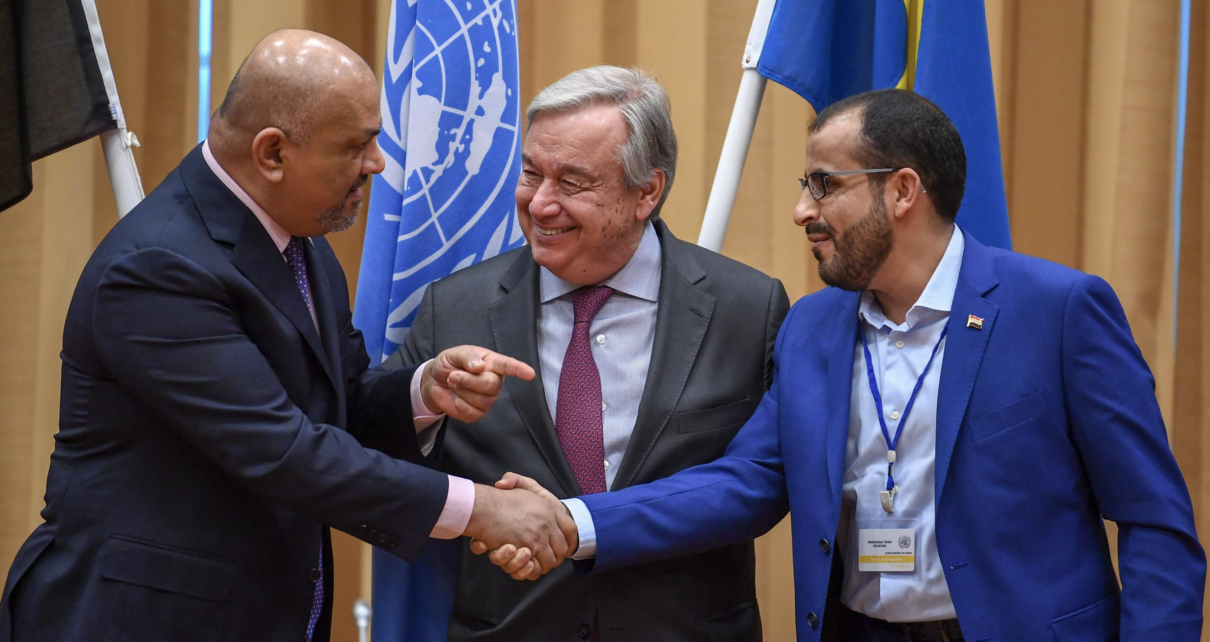The war in Yemen has come to a temporary halt, due to a UN brokered ceasefire, last Saturday. This Thursday, Yemen’s Saudi-backed President Abdrabbuh Mansour Hadi has ceded power to a newly formed ‘Presidential Leadership Council’. Western media present this as Saudi Arabia’s push for peace, when in reality it represents an admission of loss for Riyadh, and the US government.
Abdrabbuh Mansour Hadi, labelled by the West as the “internationally recognised Yemeni President”, has stepped down from his post and sacked his Vice President, Ali Mohsen al-Ahmar. He has also set up a new body to handle military, security, and political affairs during an “interim period”, according to official statements. The Kingdom of Saudi Arabia praised the move, however, the Ansarallah movement [The Houthis] which governs State affairs in Yemen, from its capital Sanaa, say the move is performative and it is Riyadh that are pulling the strings of the newly formed council.
The ‘Presidential Leadership Council’, as it calls itself, is to be headed by Rashad Al-Alimi, who served as Yemen’s interior minister under former President Ali Abdullah Saleh. The council will also be comprised of 7 deputy chairmen, all of whom are pro-Saudi Arabia.
On Friday morning, reports emerged from Yemen’s oil rich Marib province that the ‘National Army forces’ — loyal to Saudi Arabia — had attacked Ansarallah military positions in Al-Balaq Al-Sharqi, Al-Akd, Al-Faliha and Al-Naq’a. The fighting was reported to have been fierce and would represent a clear breach of the ceasefire agreement. That being said, Saudi Arabia has not yet launched airstrikes and announced any official attacks, whilst it makes gestures towards calming down the current situation with Ansarallah by allowing oil cargo to pass through its blockade.
Ansarallah sees the conflict as being between their own forces and Saudi Arabia, in addition to Riyadh’s allies. It is clear that the movement does not seek peace talks that will exclude Riyadh as being a party directly involved in the war. Saudi Arabia are now rebranding their role in this war as being one of a peace facilitator in a civil war between what they say is the “legitimate government in exile” and Ansarallah. This is clearly in defiance of reality as this is a war that started with Saudi Arabia’s military campaign in 2015.
Saudi Crown Prince, Mohammed Bin Salman, believed that the war in Yemen would take no longer than a matter of months. Despite the rhetoric of Riyadh, it is clear that instead of destroying the capabilities of the Ansarallah movement, they have only become stronger militarily since the war began and have repeatedly embarrassed Saudi Arabia and its proxy forces on the battlefield.
The strikes on Saudi Arabia’s Aramco oil facilities back in March proved that there was no military solution available to Riyadh and its Gulf Cooperation Council (GCC) allies, in Yemen. Despite the backing of the United States and United Kingdom, both diplomatically and militarily, the Saudi government realized that they were only shooting themselves in the foot by pursuing an aggressive military strategy against Sanaa. This is what prompted the UN brokered ceasefire, the need for Saudi Arabia to rebrand its role in the war and pledge that if Ansarallah goes forward with peace talks, both it and the UAE will pump 3 billion into Yemen’s economy.
The United Arab Emirates realized, earlier this January, that despite its close relationships with Tel Aviv, Washington, and London, it too was incapable of preventing breaches of its security from Yemen. The three attacks directed by Ansarallah, against both Abu Dhabi and Dubai, came as a shock to the Emirati security establishment. The drone and missile attacks from Yemen briefly turned their tourist hub nation into an unstable war zone, in response to which the United States condemned the strikes and vowed to send through more military equipment to Abu Dhabi, but fell short of living up to the requests of the UAE.
Similarly, Saudi Arabia seems to have undergone its own awakening; military escalation is no longer a viable means of ending the conflict and they understand that the further this war goes the more the oil-rich Kingdom has to lose. The US Biden administration, despite its attempts to pressure Saudi Arabia into producing more crude oil, which would effectively bring down fuel prices, has failed the Kingdom when it comes to delivering on their demands.
The next step for Riyadh is to try and establish more legitimacy, through the ever-fading relevance of the exiled Yemeni government, attempting to throw money at a solution in Yemen. However, Ansarallah has pursued a Maoist-styled Peoples War against the Saudi-led coalition and is not in weak position where it will simply bow down to bad faith peace deals. What comes next for Saudi Arabia will depend on its diplomatic savvy. If it is directed to continue the conflict by external pressures, it will only end up suffering larger military strikes. Unfortunately, the media in the West will inevitably go along with the Saudi rebranding of their role in this conflict, but this will mean little on the ground, and the legitimacy of their puppet government is extremely small inside Yemen itself.






Thank you Robert. Without your reporting none of these facts would reach us. Your work is greatly appreciated.